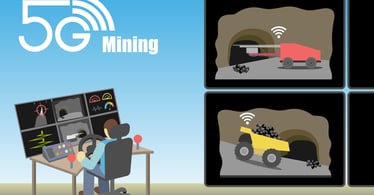Live Streaming, 5G and the Mining Industry
Whether it is open-pit mining on the surface, or underground mining from within deep tunnels, the industry is dangerous with hundreds, perhaps thousands of miners dying or being injured every year. In many parts of the world from Sweden to China, from Australia to Chile many mining companies are undergoing a digital transformation exercise to implement 5G to improve the safety of their industry as well as making the industry more environmentally sustainable.
5G can be utilized for many applications in the mining industry. For example, a mining company can use data collection and IoT devices to implement proactive maintenance, monitoring, and control of machinery in the mining operation with drone inspections, remote-controlled drilling rigs, remote vehicles, and real-time condition monitoring. But as well as data collection, live video is a critical element where cameras are used for visual or evolving AI inspections, and it also allows for the remote control of mining trucks which can be remotely operated using live streams where there are no drivers physically present in the cab.
It is estimated that “Smart Mining” with 5G applications can potentially save up to 1,000 lives and prevent 44,000 injuries over the next decade. In addition, remote-controlled drilling that relies on live streaming, is faster than manual drilling, and can increase productivity by 60%.
5G lends itself well to the physical environment and can be a platform for a single unified comms approach– given its bandwidth and low latency, 5G is not only a replacement for Wi-Fi but can actually replace LAN and fixed line cables which can be hard to implement and support in the harsh and rocky conditions of mines. Given the many advantages of automation and data collection in the mining industry, many mining companies are looking to implement their own private 5G network which is more effective to implement in such a physically challenging location.
Mining and Self Diving VehiclesBy removing operators out of the confines of their cabs and remotely placing them into air conditioned and clean environments within vehicle simulators, this reduces stress, makes for a better working environment and in turn reduces operator error, which is a big cause of mining accidents. Many parts of mines are simply too hazardous for people to operate in, such as pit walls, deep excavations and stopes and so accessing these hazardous areas has become less dangerous given the operators are remote. 5G connectivity gives live streams and a return path for remote control, not just driving, but remote operation of machines such as drilling.
Another benefit of remote driving could be the emergence of a more diverse mining workforce. The industry is traditionally male-dominated, and often involves unsociable working hours and travel to remote locations which in itself has led to a labour shortage. If new equipment is remotely operated, new remote teleoperation centers can be located in more favourable locations where workers are more prevalent. Parents with young children, who are unable to travel, or people with disabilities could operate or co-ordinate machinery, offering better opportunities for a diverse workforce to work in an automated mine environment. With a severe skills shortage impacting parts of the mining industry at present, made worse by Covid-19-related restrictions, the financial incentive to diversify the workforce has never been greater.
Automation and autonomous driving
The Pit Viper is a blasthole drilling rig and by automating the operation, it keep the logistics of transporting rig operators in and out of the mine to a minimum , even if they are in 24x7 operation. Since each explosion releases dangerous fumes that need to evaporate before any staff can be allowed into the blast area, it means remote and automated operators can begin working immediately unlike previously where the workforce would need to wait for the fumes to clear. The benefits continue – the environment benefits too. Automated, self-driving vehicles can save as much as 10 percent on the fuel consumption with the associated cost savings and the associated reduced CO2 emissions making it more environmentally sustainable, something that mining is often being challenged over.
Autonomous driving is efficient, such as when the drill rig moves from one drill hole to the next along a pre-defined path. But there are other situations, for example when there is inspection of a drill area, evaluation of rock conditions, or other exceptions outside of normal operations where only humans can make a valid assessment, and in such cases, a remote assessment would be required via a live stream camera.
Soliton and Ultra Low Latency Video Solutions
5G offers a network infrastructure that offers a unified communication channel that is high in bandwidth and low in latency. But it must be remembered that the 5G is only a network connection. When it come to live streaming video, that are other elements of the end-to-end live stream that must be considered from the camera on location to the playout in the remote location.
Typically a camera output is connected to a video encoder which converts it to a compressed IP stream, often with error correction and any encrypted protocols if the video was being transported over a public network. This will add latency in addition to any inherent 5G network delay in the 5G network. At the receiving end, the video must be decoded back to its original uncompressed stream and decrypted as appropriate. This will also add more latency before the stream is finally displayed on a monitor, simulator, or Video Management System (VMS). Traditional encoders and decoder over a cellular network back to a remote location can add as much as 1 to 3 seconds of delay. When operating in a mission-critical mining application, even a 1 second delay can be catastrophic if something were to occur and the operator had to react immediately to prevent disaster such as truck experiencing a landslide.
Soliton’s Zao range of software and hardware video encoders have been designed for mission critical application where ultra-low latency is a pre-requisite for safety with lives streaming video. They have demonstrated end-to-end delays over 4G of under 80mseconds. With 5G the latency is even lower, typically under 50ms, a figure not matched by any other manufacturer over a cellular connection from camera to the vehicle simulator in a remote location.
Summary
According to an IDC 2021 Worldwide Mining Decision Maker Survey, 86% of mining companies say they plan to invest in wireless infrastructure in the next 18 months. 5G was the overall winner in terms of highest priority because of its lower latency and higher bandwidth indicating that industry members understand high-performance private wireless networks are essential to fulfilling the demands of the next generation of mining. When it comes to live streaming video reliably within a mining environment, both in high quality and with ultra-low latency, Soliton are well placed to deliver on those needs.




